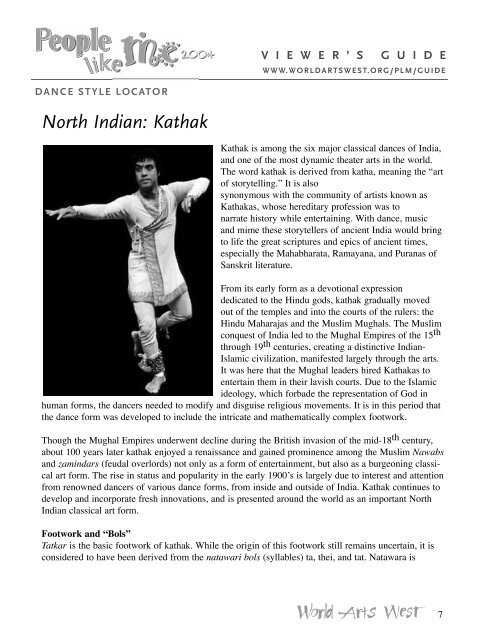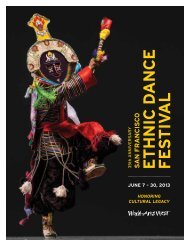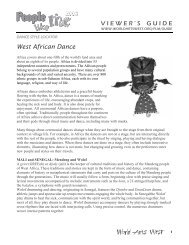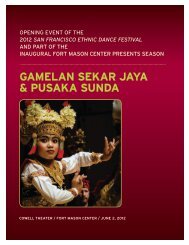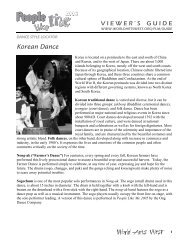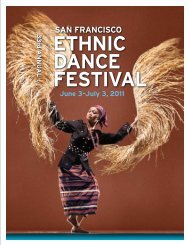South African: Gumboot dance - World Arts West
South African: Gumboot dance - World Arts West
South African: Gumboot dance - World Arts West
Create successful ePaper yourself
Turn your PDF publications into a flip-book with our unique Google optimized e-Paper software.
V I E W E R ’ S G U I D E<br />
W W W. W O R L D A R T S W E S T. O R G / P L M / G U I D E<br />
DANCE STYLE LOCATOR<br />
North Indian: Kathak<br />
Kathak is among the six major classical <strong>dance</strong>s of India,<br />
and one of the most dynamic theater arts in the world.<br />
The word kathak is derived from katha, meaning the “art<br />
of storytelling.” It is also<br />
synonymous with the community of artists known as<br />
Kathakas, whose hereditary profession was to<br />
narrate history while entertaining. With <strong>dance</strong>, music<br />
and mime these storytellers of ancient India would bring<br />
to life the great scriptures and epics of ancient times,<br />
especially the Mahabharata, Ramayana, and Puranas of<br />
Sanskrit literature.<br />
From its early form as a devotional expression<br />
dedicated to the Hindu gods, kathak gradually moved<br />
out of the temples and into the courts of the rulers: the<br />
Hindu Maharajas and the Muslim Mughals. The Muslim<br />
conquest of India led to the Mughal Empires of the 15 th<br />
through 19 th centuries, creating a distinctive Indian-<br />
Islamic civilization, manifested largely through the arts.<br />
It was here that the Mughal leaders hired Kathakas to<br />
entertain them in their lavish courts. Due to the Islamic<br />
ideology, which forbade the representation of God in<br />
human forms, the <strong>dance</strong>rs needed to modify and disguise religious movements. It is in this period that<br />
the <strong>dance</strong> form was developed to include the intricate and mathematically complex footwork.<br />
Though the Mughal Empires underwent decline during the British invasion of the mid-18 th century,<br />
about 100 years later kathak enjoyed a renaissance and gained prominence among the Muslim Nawabs<br />
and zamindars (feudal overlords) not only as a form of entertainment, but also as a burgeoning classical<br />
art form. The rise in status and popularity in the early 1900ʼs is largely due to interest and attention<br />
from renowned <strong>dance</strong>rs of various <strong>dance</strong> forms, from inside and outside of India. Kathak continues to<br />
develop and incorporate fresh innovations, and is presented around the world as an important North<br />
Indian classical art form.<br />
Footwork and “Bols”<br />
Tatkar is the basic footwork of kathak. While the origin of this footwork still remains uncertain, it is<br />
considered to have been derived from the natawari bols (syllables) ta, thei, and tat. Natawara is<br />
7


